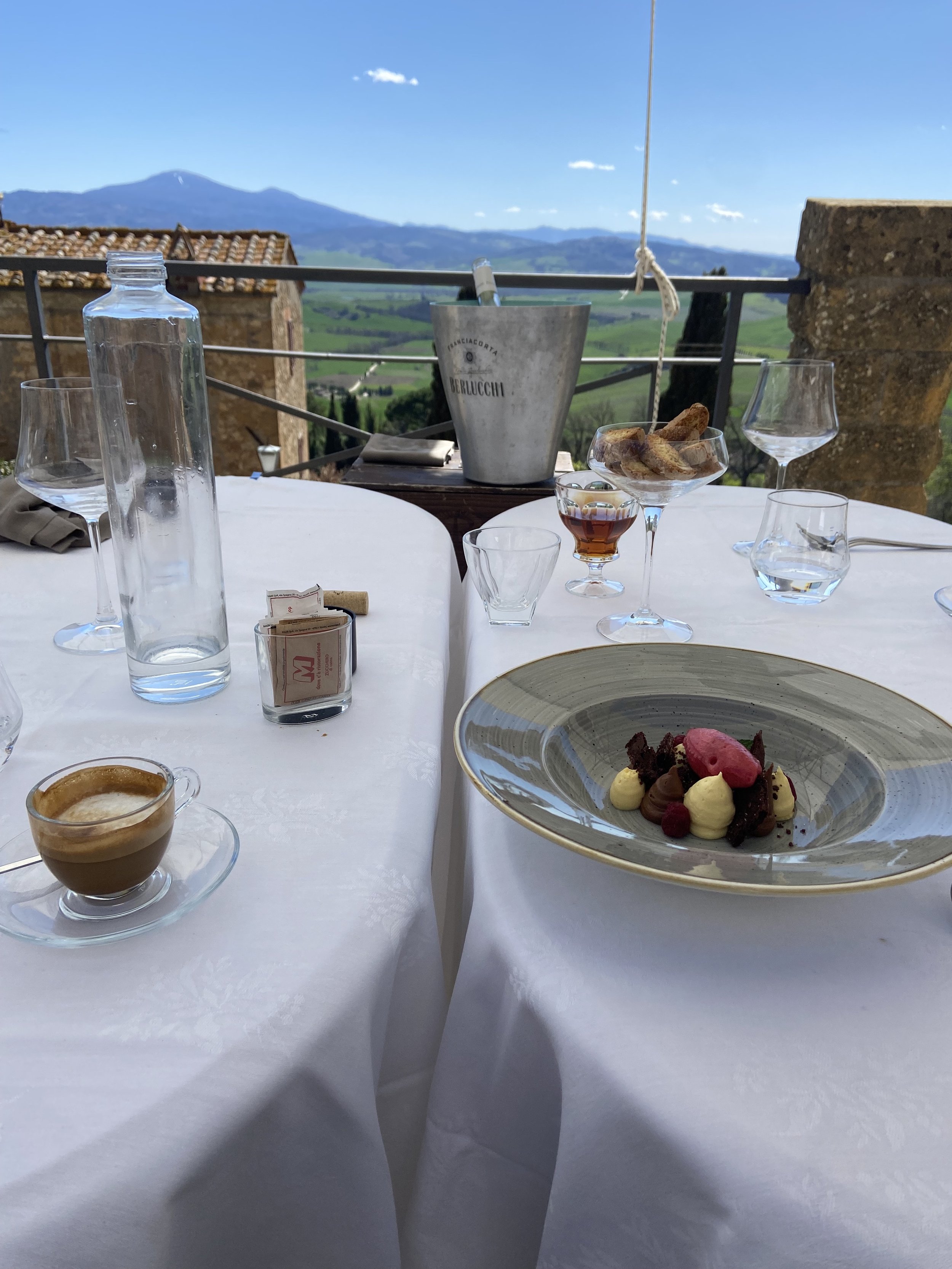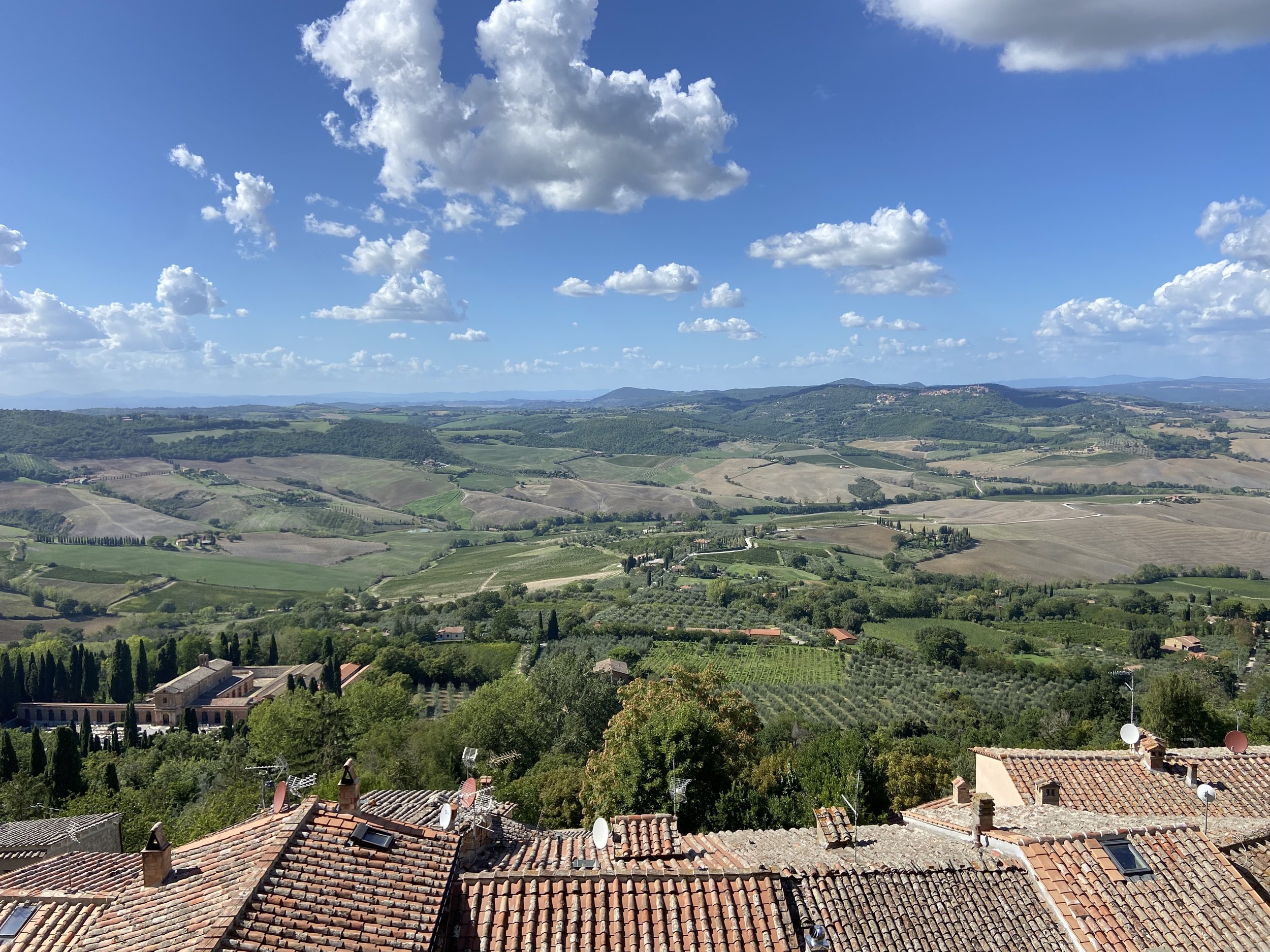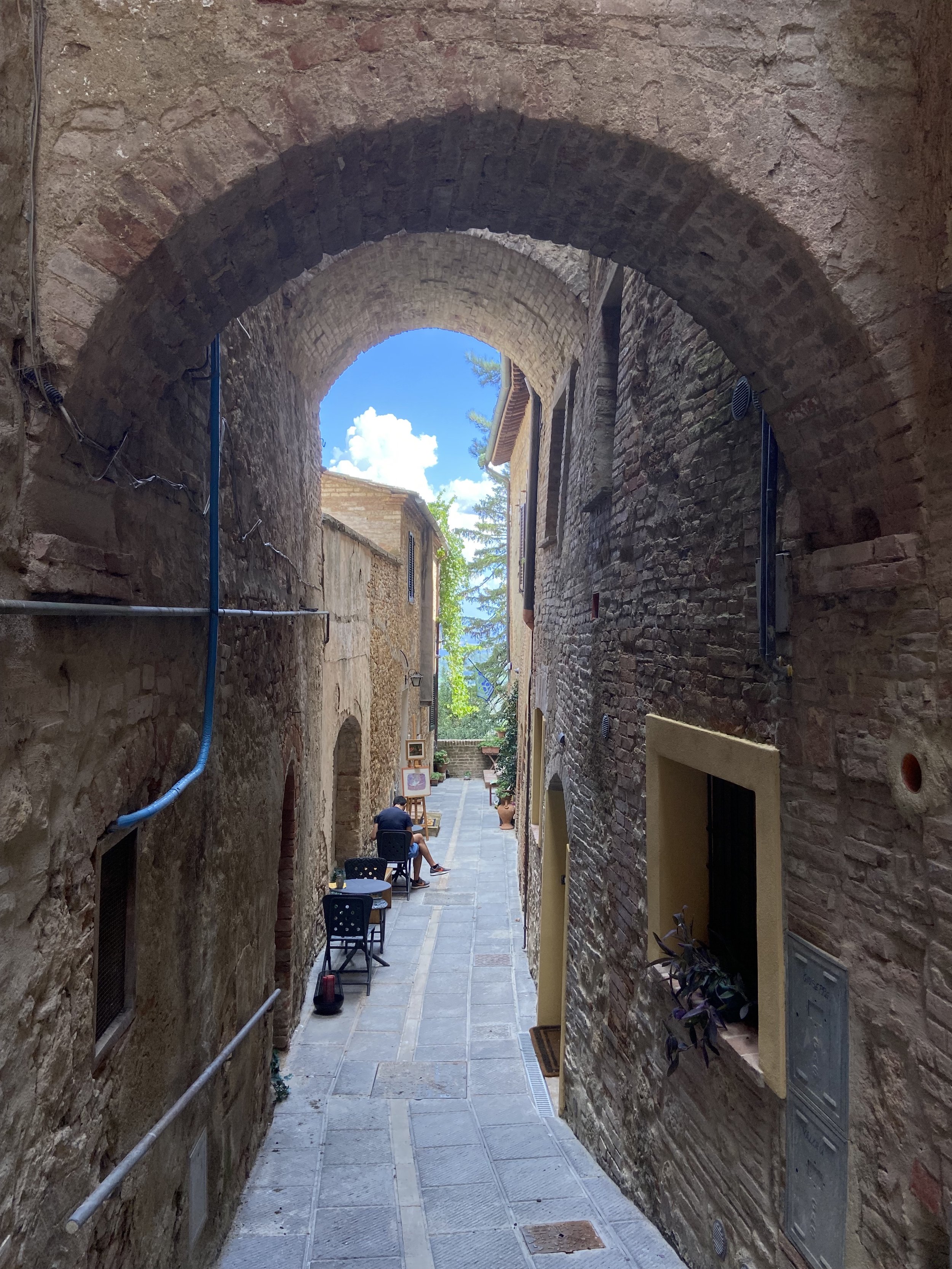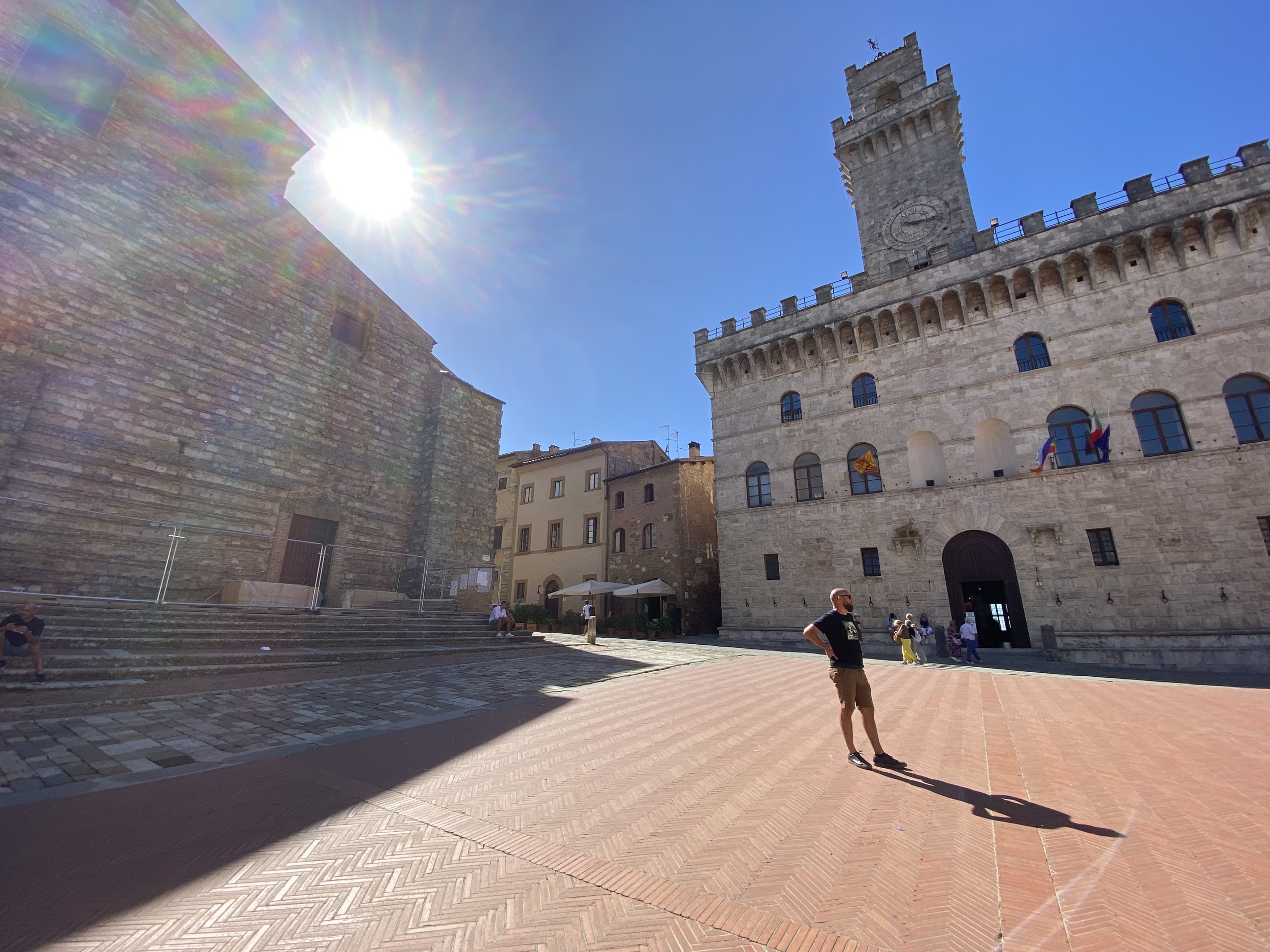Regional Features for 2022— Pienza, Montepulciano and Pitigliano
Pienza
In addition to the Val ‘Orcia at large, the town of Pienza also has a special UNESCO designation in that the historical center of the town is recongnized as the “ideal city” in terms of the “Renaissance humanist concept of urban design.” Indeed, after a return trip in the spring of 2022, I agree that Pienza is worthy of distinction.
Eat at La Terrazza Del Chiostro. The views from the tables lined up on the outdoor terrace are magnificent. Elegant white tables are positioned under matching white umbrellas with a front row seat to the panoramic landscape painting of the Val d’Orcia. I had read that the restaurant features briefly in the third season of HBO’s popular series Succession, which honestly gave me cause for pause upon booking for lunch because sometimes when places are too exposed the quality can wane. The restaurant was also recommended, however, by another friend who spends a lot of time in the area. And although I was mesmerized by the view throughout the meal, I was also pleased with the quality of the food. The ‘Chiostro’ also boasts history in addition to beauty. It is a 4 star hotel (although I cannot vouch for it as a hotel as we did not stay there). Still, as I have already described the ‘terrazza’, I would add that the ‘chiostro’ meaning cloister was part of a monastery of St. Francis, on the grounds since the early 14th century. This restaurant also has added personal significance as my parents met my partner there for the first time. There is no completely objective personal recommendation, right? Regardless, it is a special place with quality Tuscan fare, and I encourage you to experience it for yourselves!
Stroll around the quaint town and experience the ‘ideal city’ at your own pace. The main piazza which contains the Palazzo Piccolomini is a good starting point after emerging from a delightful lunch at the Terazza Del Chiostro. As mentioned in the UNESCO criteria, the Renaissance pope, Pius II (Piccolomini), was born in Pienza and began to “transform the look of his birthplace” in 1459 with the help of architect Bernardo Rossellino. Explore his namesake palace, the Borgia palace (now the The Diocesan Museum of Pienza) and the central cathedral, the Cattedrale dell’Assunta.
Take in the views from the city as you stroll around. Some of the best views of the Val d’Orcia are from the town of Pienza. I would recommend taking an hour or so to stroll around the interior (find the Via Dell’Amore, Via Del Bacio and Via Della Fortuna, for example), and then indulge in the panorama as there are enchanting viewpoints to discover as you make your way around the Tuscan town. I will end with a last fun fact, the charming town of Pienza truly embodies the Renaissance as it was revitalized and even renamed Pienza, literally ‘the city of Pius’. Before and until medieval times the city was known as Corsignano.
Montepulciano
I still, personally, prefer Montalcino, but choosing between these two towns is a auspicious dilemma to be faced with, let’s face it. (No one is holding a gun to my head to make the comparison either!) Further, this is the beauty of travel. On a return visit to Montepulciano, a decade later, I enjoyed the city more than the first time, and differently. Could be the season, the company (on both occasions company was excellent), particular streets explored, these nuances of experience that of course make recommendations ‘tricky’ to a certain extent. Travel is a personal, subjective, complex entity of experience. My experience will inevitably not be yours, and as demonstrated in my Montepulciano experience, it might not even be mine at another point in time. I would like to recommend places, restaurants, and specific spots to help you craft your experience, but there are a number of factors that can never be premeditated.
I returned recently to Montepulciano in the fall of 2022, the town having not made a particularly memorable impression the first time I visited in 2010. We stopped by, just for lunch, on a drive from Liguria back to Rome. I used the trusty App for natural wine called Raisin, also a great resource for restaurants and wine bars that focus on using high quality ingredients in their foods to accompany the wine. Often, the philosophy for winemakers in privileging natural methods for wine production is accompanied by a focus on organic and local products in the food at the recommended establishments. We found Enoteca Caratello’s to be just what we were looking for.
Sip wine at Enoteca Caratello’s. They have carefully crafted taglieri (selection of local meats, cheeses and more), curated selection of wines, personal attention, and two top tables down a discrete little alley way with a window into those coveted Tuscan views from which one can never tire.
Discover the Torre di Pulcinella. If you are looking for a mysterious Italian literary connection, this tower has it. The character of Pulcinella originates from the famous form of Italian comedy, the Commedia dell’arte; this character, however, did not emerge until the 17th century, but became an archetypal character, particularly connected to the city of Naples. In fact, the Pulcinella is said to represent the Neopolitan ‘everyman’. Thus, how did this 17th century figure, so connected to Neopolitan culture, end up in Montepulciano? Well, that is where the mystery comes in. Read a bit more in depth here and enter the spot into your Google maps to observe the incongruence for yourself!
Take it all in and take some pictures of the Piazza Grande. A pop culture connection that was trending when I visited for the first time in 2010 was related to the Twilight ‘saga’, specifically the film “New Moon”, based on the hit YA books by Stephanie Meyer. Scenes from this film were shot right here in the central piazza of Montepulciano. The iconic clock tower, part of the Comune building, features prominently. Of course there is centuries old history to explore in this important square as well, namely, the 16th century Palazzo Nobili-Tarugi, the Cattedrale di Santa Maria Assunta, built between 1586 -1680, and the 1520 Pozzo dei Grifi e dei Leoni.
Pitigliano
Like most Italian regions, the potential for exploration and discovery of perfect little towns seems limitless. Start a sentence with “Have you been to…” and Tuscany will continue to delight and surprise with hamlets to add to your list. Pitigliano was one of these towns for me. The name was familiar, but I didn’t make it until after over a decade of living in Italy and exploring the region of Tuscany. It is a wonderful town! We stayed there to be in proximity to the natural baths of Saturnia. (We went to the baths at night which was special and romantic to be embraced by the warm sulphuric waters of the natural pools, stargazing above. That said, my pictures are not the most representative of the place; find a rather comprehensive post on visiting the hot springs at Saturnia here.) Pitigliano is worthy of a visit alone, however.
Take in the luminous golden views of the town by night as pictured above. Like so many Tuscan towns, Pitigliano is beautiful from the interior and the exterior. I would recommend finding time to see both views!
Walk on the Etruscan roads, the so-called Vie Cave. You can access these ancient Etruscan trails easily from the center of the town as there are signs indicating the way. These pathways are carved from the soft and malleable Tufa stone, which also creates the foundation for the town of Pitigliano above. ‘Cave’ is the plural of ‘Cava’ (quarry, mine or pit) and thus it does not translate to the English word ‘cave’ although you will find some interesting caves and tombs throughout this ancient Etruscan system of roads (vie). The network extends throughout neighboring towns of Sovana and Sorano. Interestingly, all of these towns, although in Tuscany, are so close to the border with the ‘modern’ Lazio region. I say ‘modern’ as the Etruscan area, ancient Etruria, as discussed in other posts such as this one, spans the modern day regions of northern Lazio, parts of Umbria and Tuscany. Thus, the ancient Etruscan cultural connections remain strong even today and do not respect these modern divisions (as in many places around the world.)
Explore the Jewish quarter and learn about the important Jewish history in Pitigliano. The city holds the epithet of ‘Little Jerusalem’. The Jewish community came to Pitigliano in large numbers after the restrictive and ‘absurd’ Papal Bull issued by Paul IV in 1555 led many to flee Rome. The noble Orsini family (local rulers at the time) did not support the current Pope and welcomed the community. Learn more through a visit to the Jewish museum and the Synagogue, built in1598. Don’t forget to try and buy ‘Sfratti’, a traditional sweet made with walnuts, honey, orange peel and spices. Find out more about the origin of the name and try your hand at a recipe here!







